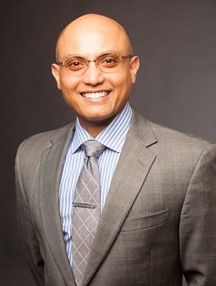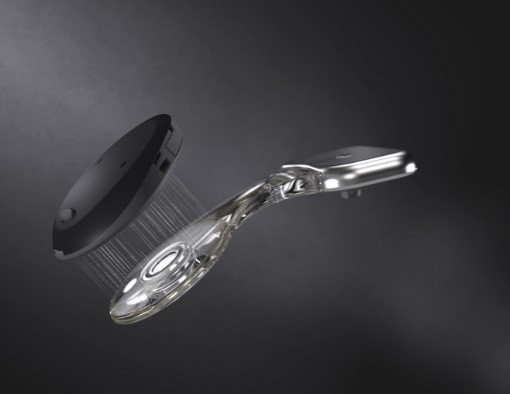Abraham Jacob, MD

Medical Director, Ear & Hearing
Center for Neurosciences in Tucson, Arizona
Dr. Jacob discusses the new Cochlear™ Osia® System, the world’s first and only Active Osseointegrated Steady-State Implant (OSI). Selected for the Osia System control market release (CMR), he uses 13 years of surgical cochlear implant/bone conduction experience to review his initial experience with the system.
What initially attracted you to the Cochlear™ Osia® System?
Several things attracted me to the Osia System, including an added implant portfolio option. The operation was easy to learn since site placement is similar to the Baha® System, but with many added benefits including:
- Exceptional mid and high-frequency gain1
- No external abutment required
- Lightweight and cosmetically appealing external sound processor
- Passive processor with active internal device
How does implanting the Osia System compare to the Baha Connect and Baha Attract?
The Osia System combines the cosmetic appeal and easy aftercare of Attract with substantially improved mid- and high-frequency gains. Our patients comment that the Osia System sounds fuller and more natural than what they experienced in their Baha Softband simulations prior to surgery.
The operation itself is more involved and scenario-based, typically taking about twice as long in patients getting an incision anterior to their implant and about three times as long in patients whose incisions are posterior to their implant. Overall, the operation takes 30-45 minutes in most patients. Positioning the head correctly is particularly important in Osia surgery where one has a larger body habitus or limited neck mobility.
What does the Osia System mean for patients with single-sided deafness (SSD)?
For SSD patients, the Osia System offers improved cosmetics, no external abutment and improved mid/high frequency gain. The latter translates to improved sound quality, as described by the four patients whose devices have already been activated at our facility.
These patients have reported benefits such as immediate audibility at activation. This initial experience is fulfilling for the patient, surgeon, audiologist and all involved.
How is the Osia System changing your practice? What makes you excited about the system?
The powered internal device is a paradigm shift for delivering audibility through bone conduction. If there are no patient-specific or financial barriers to accessing this technology, I believe active implants would be first choice. It all comes down to thinking about patient benefit.
How many Osia Systems have you scheduled and/or implanted so far?

I have performed six operations in the past two months and have a list of 12 other patients interested in the device. Indications for surgery in my first six patients ranged from SSD to mixed-conductive hearing loss, some receiving anterior incisions and others requiring posterior incisions. It is all very exciting.
What are some best practices you’ve developed, or lessons learned through Osia System surgeries?
As mentioned, I have implanted some patients with SSD and some with mixed-conductive hearing losses. Those without prior history of ear surgery received incisions anterior to their implant while posterior incisions were used in those with pre-existing mastoid cavities or history of acoustic neuroma resection.
The posterior approach takes longer and can be a bit more difficult in patients having limited neck mobility and/or those with short necks. It’s important to gain more visibility to the site with these patients. It’s important to position the head more deliberately in such patients to ensure adequate visibility.
With posterior incisions, I think being 10 mm from the posterior margin of the implant is fine. With the anterior incision, it is important to be 10-15 mm anterior to the implant’s anterior margin. Lastly, I advise starting with a smaller incision and leaving markings if you need to expand during the course of the surgery.
What is the average time is takes you to surgically implant an Osia device?
Implant time really depends on the patient and the incision. With the anterior incision, it takes about 20-30 minutes from incision to implant in place. Patients requiring the posterior incision take 30-50 minutes from incision to implant in place. Closure is shorter for those requiring an anterior incision. The longest operative time was for a posterior incision patient with thick neck and limited neck range of motion.
How does the addition of the Osia System to your armamentarium transform how you counsel patients?
We performed a total of 38 Baha Attract implants, Baha Connect implants and other bone conduction solutions in 2019 prior to Osia; therefore, our practice and our patients are very open to bone conduction as a viable and effective means of aural rehabilitation. Devices with an external abutment offered improved audibility while potentially sacrificing cosmesis and aftercare. With Osia, we now have the best of all worlds – great audibility and a small, light & comfortable sound processor.
As the one of first surgeons to implant the Osia System, do you have anything else to add?
Our initial impressions from the patients’ activated so far had improved gain, quality of the sound and cosmetics. Without barriers to access if bone conduction is the right option, the Osia System’s gain is a game-changer for both surgeons and patients.
For more information about the Osia System, subscribe to Cochlear ProNews or visit our website.
References:
- Dotevall M. Technical Report: Available gain in Osia vs Baha 5 Power. D1664198. Cochlear Bone Anchored Solutions AB, Sweden 2019
The Osia 2 System is intended for the following patients and indications: • Patients 12 years of age or older. • Patients who have a conductive or mixed hearing loss and still can benefit from sound amplification. The pure tone average (PTA) bone conduction (BC) threshold (measured at 0.5, 1, 2, and 3 kHz) should be better than or equal to 55 dB HL. • Bilateral fitting of the Osia 2 System is intended for patients having a symmetrically conductive or mixed hearing loss. The difference between the left and right sides’ BC thresholds should be less than 10 dB on average measured at 0.5, 1, 2, and 3 kHz, or less than 15 dB at individual frequencies. • Patients who have profound sensorineural hearing loss in one ear and normal hearing in the opposite ear (i.e., singlesided deafness or “SSD”). The pure tone average air conduction hearing thresholds of the hearing ear should be better than or equal to 20 dB HL (measured at 0.5, 1, 2, and 3 kHz). • The Osia 2 System for SSD is also indicated for any patient who is indicated for an air-conduction contralateral routing of signals (AC CROS) hearing aid, but who for some reason cannot or will not use an AC CROS. • Prior to receiving the device, it is recommended that an individual have experience with appropriately fitted air conduction or bone conduction hearing aids.
This article expresses the experience and opinions of Dr. Abraham Jacob. Please see Cochlear’s surgery recommendations as well prior to performing an Osia System surgery.


